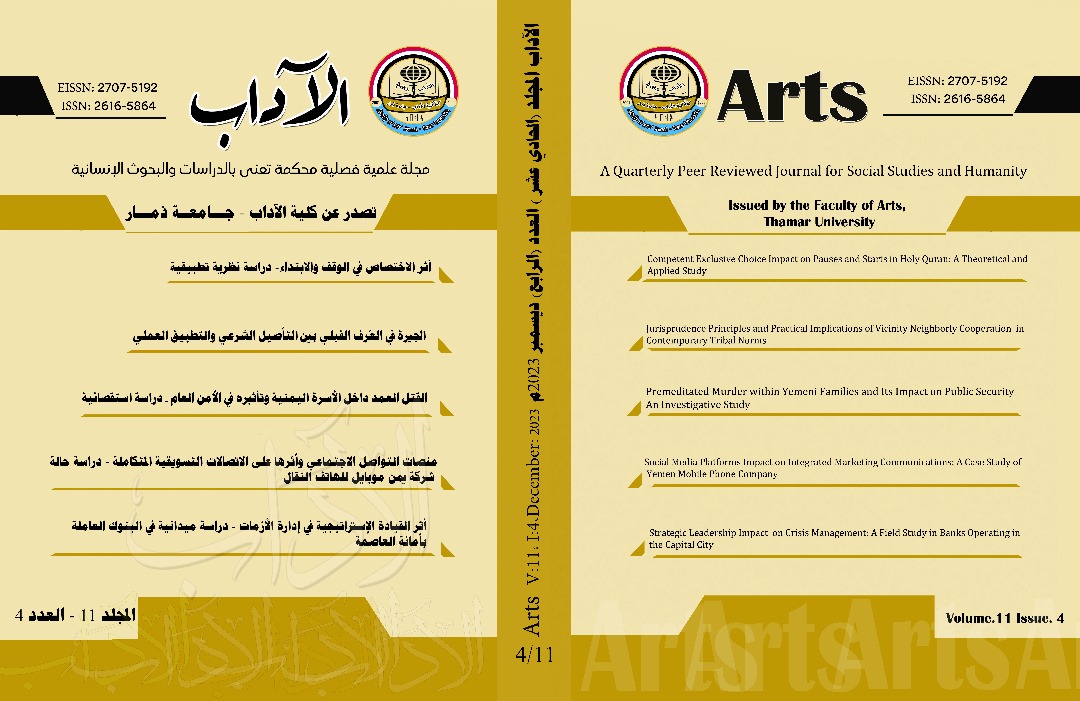Mahdist Movement Political Dimensions in Sudan: Islamic State Creation Religious Mentality during the Nineteenth Century (1884 -1881).
DOI:
https://doi.org/10.35696/arts.v11i4.1702Keywords:
Mahdism, Political Islam, Sufiism, SudanAbstract
This article examines the religious mentality in the nineteenth century Middle with reference to Mahdi movement political dimensions in Sudan during the early eighties. The study is organized into four sections which cover, historical background of the 19th Century Sudan, the emergence of the Mahdism in 1881 in Sudan, the political aspects of the Mahdist movement in Sudan, and local opposition against the Mahdist movement. The study key findings showed that the Sudanese Mahdi, Mohammed Ahmad, had been affected by number of factors shaping his religious mentality embodied in the idea of Mahdism. It was concluded that such mentality was evident in the political aspects the movement and local opposition. It was also revealed that those factors played such a vital role in the movement's prosperity that ordinary Sudanese people regarded Mohammed Ahmed, in sharp contrast to Mahdi-opposition loyal scholars (Ulama), as a savior capable of liberating Sudan from foreign rule.Downloads
References
Affairs of Egypt, Egypt. No. I (1884), 92-93.
Mahdi, Mohammed Ahmed, Manshurat al-Mahdi, edited by Mohammed Ibrahim (Beirut,
.
-------------------------- Manshūrāt al-Mahdīyah. Edited by Muḥammad Ibrāhīm Abū Salīm. (Beirut, 1969)
B. Secondary Sources:
Abdul Rahaman, A. A. Toshka (Dar of Khartoum University, Sudan. 1979).
Abu Salem, M. I. al-harakah al-fikryya fi al-Mahdyya (Sudan. University of Khartoum Press).
Al-Kordofany, I. A. Sa'adt al-Mustahdy be Seerat al-Imam al-Mahdi. Edited by Mohammed Ibrahim Abu Salim (Beirut, Dar al-Jeel, 1982).
Al-Qaddāl,. Tārīkh al-Sūdan al-ḥadīth, 1820-1955 (Cairo : s.n., 1993)
Clarke, John Henrik, “Mohammed Ahmed, (The Mahdi) Messiah of the Sudan”, The Journal of Negro Education, Vol. 30, No. 2 (Spring, 1961), 156-162.
Fawzi, Ibrahim Pasha. Al-Sudan ben ydee Gordon wa Kitchener (Cairo, Jaredat al-Mu’ed, 1901).
F. R. Winggate. Mahdism and the Egyptian Sudan (London, Frank Cass, 1968).
Holt. P. M. “The Sudanese Mahdia and the Outside World: 1881-9”. Bulletin of the School of Oriental and African Studies, University of London, Vol. 21,No. 1/3 (1958), pp. 276-290.
Holt. P. H. The Mahdist State in the Sudan, 1881-1898 (Oxford: Oxford University Press, 1958).
Holt. P. M. A Modern History of the Sudan (New York. Frederick A. Praeger, 1963).
Kapteijns, Lidwien, “Mahdist Faith and the Legitimation of Popular Revolt in Western Sudan”, Africa: Journal of the International African Institute, Vol. 55, No. 4, Popular Islam (1985), 390-399.
Malik, M. M. al-Muqauamah al-Dakiliah le Harkat al-Mahdiyah (Dar al-Jeel. Beirut, 1987).
Robinson, Ronald & Gallagher, and John. African and the Victorians (United States of America: Anchor Books, 1968).
Shbikah, Maki. al-Sudan wa al-thourah al-Mahdyya, vol.1 (Khartoum: University of Khartoum Press).
Shalaby, A. Al-Usoul al-Fikryya le Harakt al-Mahdi al-Sudani wa da'wath (Cairo. Matabt al-Adab. 2001).
Shuqayr, Naʻʻūm. Taʼrikh Al-Sudah (The History and Geography of the Sudan) (Matb'at al- Ma'arf. 1903).
Ibrahim, Abdullah Ali, al-Sera’a ben al-Mahdi wa al-Ulama, (Cairo: The Sundance Studies Center, 1994).
Hasan, Ibrāhīm Shihātah. Imārat al-Islām "al-Mahdīyah" fī al-Sūdān: dars fī al-tārīkh ʻabraʻalāqāt Miṣr wa-al-Sūdān bi-al-qarn (al-Qāhirah : Dār al-Maʻārif, 1985).
Powell, Eve M. Troutt. A differentsShade of colonialism: Egypt, Great Britain, and mastery of the Sudan (Berkeley. University of California Press, 2003).
Voll, John, “The Sudanese Mahdi: Frontier Fundamentalist”, International Journal of Middle East Studies, Vol. 10, No. 2 (May 1979), 145-166.
Yahya, Jalal, al-thaworah al-Mahdyya wa Usuol al-Syyasah al-Biratanyya fi al-Sudan (Cairo, Maktabit al-Nahthah al-Miseryyah, 1959).
Downloads
Published
How to Cite
Issue
Section
License

This work is licensed under a Creative Commons Attribution 4.0 International License.
Copyright and Licensing
For all articles published in journal, copyright is retained by the authors. Articles are licensed under an open access Creative Commons CC BY 4.0 license, meaning that anyone may download and read the paper for free. In addition, the article may be reused and quoted provided that the original published version is cited. These conditions allow for maximum use and exposure of the work.



